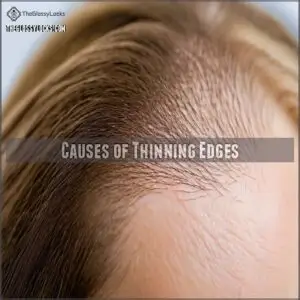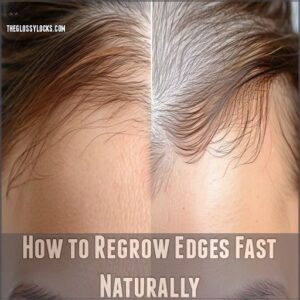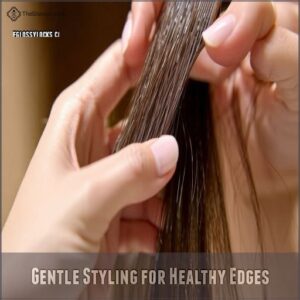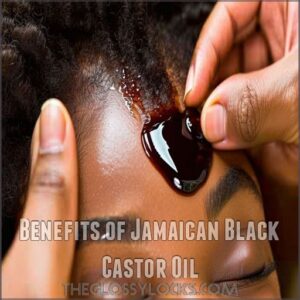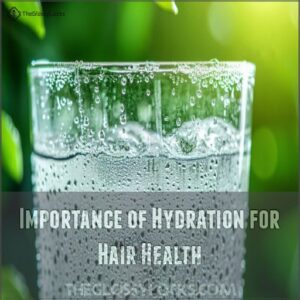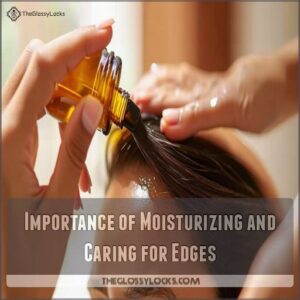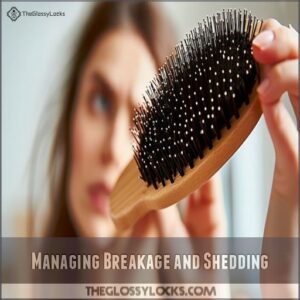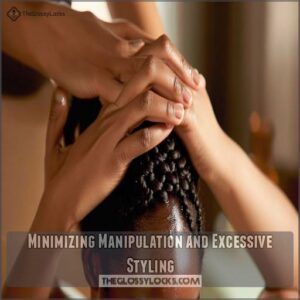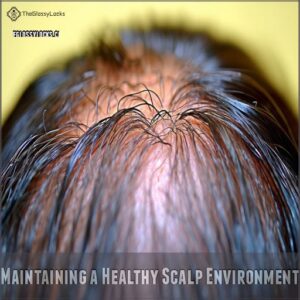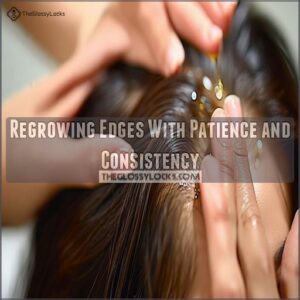This site is supported by our readers. We may earn a commission, at no cost to you, if you purchase through links.
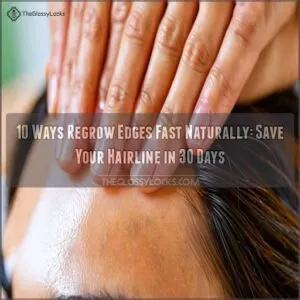 You can regrow your edges fast with these 10 natural tips.
You can regrow your edges fast with these 10 natural tips.
First, be gentle – avoid pulling your hair too tight.
Next, moisturize and deep condition regularly to strengthen strands.
Try a protein treatment to fortify your edges.
Always use a heat protectant when styling.
Check for any underlying medical conditions causing hair loss.
Give your scalp a massage to boost circulation and growth.
Opt for protective styles that reduce tension.
And don’t forget – patience is key.
With a consistent, gentle routine, you’ll have your edges back in no time.
Ready to take control of your hairline? Learn more transformative tips.
Table Of Contents
- Key Takeaways
- Causes of Thinning Edges
- How to Regrow Edges Fast Naturally
- Gentle Styling for Healthy Edges
- Natural Remedies for Thinning Edges
- Importance of Moisturizing and Caring for Edges
- Managing Breakage and Shedding
- Protective Styling for Edge Regrowth
- Maintaining a Healthy Scalp Environment
- Regrowing Edges With Patience and Consistency
- Monitoring Progress and Adjusting Your Approach
- Frequently Asked Questions (FAQs)
- How do I grow back my edges?
- Can You Grow Your edges back?
- How to grow edges back on top of a solid regimen?
- Can you grow back thinning hair edges?
- How can I keep my edges healthy?
- What should I do if my edges are thinning?
- How do I grow my edges back quickly?
- How do I grow my hairline back naturally?
- Can hair grow back in 3 weeks?
- How to restore a damaged hairline?
- How can I identify the cause of my thinning edges?
- What supplements help with edge regrowth?
- Is laser therapy effective for improving thinning edges?
- How do I encourage new hair growth on my edges?
- When should I see a dermatologist about my edge concerns?
- Conclusion
Key Takeaways
- Be gentle with your hair by avoiding tight hairstyles and harsh manipulations to protect your edges and promote growth.
- Regularly moisturize and nourish your edges with natural oils like peppermint or castor oil to enhance blood flow and strengthen your hairline.
- Avoid chemicals and excessive use of styling products that can lead to breakage by choosing gentle, sulfate-free formulas and low-manipulation hairstyles.
- Keep a healthy diet rich in essential nutrients like biotin, iron, and protein to support hair regrowth and maintain a healthy hairline.
Causes of Thinning Edges
You’re probably wondering why your edges are starting to look thinner than your grandmother’s famous pound cake recipe.
Your daily hair care routine might be secretly working against you, from those trendy tight hairstyles to harsh chemicals in your favorite products that can damage your fragile hairline.
Chemical Exposure and Hair Damage
Every time you reach for those chemical treatments, you’re playing Russian roulette with your edges. The harsh truth is that relaxers and hair dyes can wreak havoc on your hairline’s health. It’s not just about the immediate burn – these chemicals are slowly compromising your hair’s structure.
- Relaxers contain sodium hydroxide that breaks down protein bonds
- Hair dyes strip natural oils, leaving edges brittle
- Chemical buildup causes scalp inflammation and stunts growth
Tight Hairstyles and Traction Alopecia
Tight hairstyles might seem like a quick fix for sleek edges, but they’re actually your hairline’s worst enemy.
When you constantly wear tight braids, ponytails, or weaves, you’re putting excessive tension on your hair follicles.
This stress can lead to traction alopecia – permanent hair loss that starts at your edges and works its way back.
Loosen up those styles to keep your edges intact.
Excessive Use of Edge Control Treatment
Your edge control routine could be silently sabotaging your hairline.
Beyond the tight styles we discussed, those edge control products you’re using daily? They’re often packed with harsh ingredients that can clog hair follicles and irritate your scalp.
Think of it like suffocating your edges – many popular products, such as those with frizz-busting styling formulas, can build up over time, potentially leading to inflammation and gradual thinning.
Think of it like suffocating your edges – the alcohol, preservatives, and heavy waxes build up over time, potentially leading to inflammation and gradual thinning.
Excessive Manipulation and Breakage
Daily hair-handling habits can make or break your edges – literally.
When you’re constantly brushing, styling, or touching those delicate baby hairs, you’re creating friction that leads to breakage.
Think of your edges like fine silk – the more you handle them, the more likely they’ll wear thin.
Harsh brushing and aggressive styling tools can also damage the hair shaft, leading to permanent thinning.
How to Regrow Edges Fast Naturally
Looking for fast, natural ways to regrow those edges. Think of your edges as a garden – they need the right nutrients and care to flourish. Start by switching to natural alternatives that promote healthy growth, and consider using clinically proven treatments like overnight hair growth remedies to boost hair thickness.
Here’s your power plan for edge restoration:
- Massage your scalp daily with peppermint oil mixed with jojoba oil – studies show this combo increases blood flow and stimulates follicles within 30 days.
- Boost your nutrition game with biotin-rich foods like eggs, nuts, and leafy greens – they’re your hair’s best friends.
- Apply a weekly DIY hair mask using avocado, honey, and coconut oil to deeply nourish those delicate edges.
Remember, consistency is key. Track your progress with weekly photos to celebrate small wins.
Gentle Styling for Healthy Edges
You’ll be amazed at how your edges can transform when you adopt gentler styling habits that protect your hairline from unnecessary stress and strain.
By making simple changes to your daily routine, like avoiding tight styles and harsh manipulation, you’ll give your edges the tender loving care they need to thrive and regrow naturally.
Avoiding Excessive Manipulation and Breakage
Taking control of edge health starts with gentle handling. Let’s break down exactly how to avoid damaging those delicate baby hairs while still achieving your desired style.
| Handling Technique | Impact on Edges | Prevention Strategy |
|---|---|---|
| Aggressive brushing | Breaks hair strands | Use soft bristle brush |
| Tight headbands | Creates tension | Choose fabric bands |
| Constant touching | Transfers oils | Keep hands away |
| Rough detangling | Pulls out edges | Start from tips up |
| Metal accessories | Snags hair | Switch to covered elastics |
Learn to recognize when you’re being too rough with your edges – they’ll thank you with fuller growth.
Changing Hairstyles to Reduce Tension
By switching up your hairstyles regularly, you’re giving your edges the break they desperately need.
Instead of tight ponytails and braids, opt for low-manipulation styles like loose twists or soft buns.
Rotate between different styles every 2-3 weeks to prevent constant tension in one area.
Think of your edges like a delicate plant – they need gentle care to flourish and grow strong.
Minimizing Heat Styling and Damage
Now that you’ve switched to gentler styles, let’s tackle another edge-killer: heat styling.
Your flat iron might give you that sleek look, but it’s secretly sabotaging your edges.
When you must use heat, always apply a heat protectant and keep the temperature below 350°F.
Better yet, embrace air-drying and natural styles – your edges will thank you with new growth.
Natural Remedies for Thinning Edges
Tired of thinning edges? You’re in luck!
Natural remedies like peppermint oil, Jamaican black castor oil, and a healthy diet can help regrow your edges fast.
Get ready to say goodbye to that receding hairline in just 30 days.
Using Peppermint Oil for Hair Growth
Peppermint oil is a powerful natural remedy for thinning edges.
Its antimicrobial and anti-inflammatory properties can stimulate blood flow and hair follicle activity, promoting healthy regrowth.
Mix a few drops with a carrier oil, then gently massage into your hairline.
Say goodbye to sparse edges – peppermint oil is your secret weapon for a lush, full hairline.
Benefits of Jamaican Black Castor Oil
Jamaican black castor oil is a game-changer for thinning edges.
Its rich nutrients nourish the scalp, while the anti-inflammatory properties soothe irritation.
Plus, the thick, moisturizing texture seals in hydration, strengthening fragile hairs and preventing further breakage.
Massage it into your hairline for a visible boost in density and shine.
Role of Healthy Diet in Hair Regrowth
Your diet plays a pivotal role in hair regrowth.
Protein-rich foods like eggs, lean meats, and beans nourish follicles and stimulate growth.
Leafy greens, nuts, and fatty fish provide essential vitamins and minerals to strengthen strands.
Avoid nutrient deficiencies by eating a balanced diet – your edges will thank you!
| Nutrient | Benefits for Hair |
|---|---|
| Protein | Supports hair structure and growth |
| Iron | Aids oxygen transport to follicles |
| Biotin | Promotes keratin production |
| Zinc | Regulates oil glands and repair |
| Vitamin C | Enhances collagen for healthy scalp |
Benefits of Jamaican Black Castor Oil
Importance of Hydration for Hair Health
Staying hydrated is essential for healthy hair growth.
Proper hydration makes sure your scalp and hair follicles get the nourishment they need.
Dehydration can cause dryness, brittleness, and breakage.
Sip water throughout the day and consider adding hydrating hair masks to your routine.
Your edges will thank you for keeping them moisturized.
Importance of Moisturizing and Caring for Edges
Your edges are the most fragile parts of your hair, so keeping them properly moisturized and cared for is key to achieving fast, natural regrowth.
Use nourishing natural oils and deep conditioning treatments to strengthen and revive thinning edges, and protect them from friction with satin or silk accessories.
Using Natural Oils and Hair Masks
By infusing your strands with nourishing natural oils and hair masks, you can restore luster and resiliency to your edges.
Reach for potent ingredients like coconut, argan, or peppermint oil to intensely hydrate and promote healthier growth.
For an extra nourishing boost, try shopping for argan oil products specially formulated here for your edges.
Pamper your hairline with a weekly DIY hair mask – your tresses will drink up the goodness!
Benefits of Deep Conditioning and Protein Treatment
Indulge your hair with a nourishing deep conditioning treatment to revive dry, damaged edges.
The moisture and protein boost reinforce fragile strands, restoring strength and elasticity.
Make this a weekly ritual – your parched hairline will thank you.
Pair with a rejuvenating hair mask for an extra surge of hydration.
Protecting Edges With Satin or Silk
Protect your delicate edges with the luxurious embrace of satin or silk.
These soft, friction-reducing fabrics glide gently over your hairline, preventing breakage and preserving precious strands.
Swap your cotton pillowcase for a satin version, or wrap your edges in a silk scarf before bed.
Your hair will thank you!
Managing Breakage and Shedding
Are you noticing more hair in your brush than usual?
Don’t worry—we’ve got you covered.
In this section, we’ll help you differentiate between healthy shedding and concerning breakage, so you can get to the root of the issue and start regrowing those edges.
Differentiating Between Breakage and Shedding
Let’s get clear on the difference between breakage and shedding.
Breakage happens when the hair shaft snaps or splits, while shedding involves the hair loosening from the bulb.
Examine your strands closely – if you notice more broken bits than full hairs, that’s a sign you’ve got some edge-repairing work to do.
Identifying Underlying Causes of Hair Loss
If you’re experiencing excessive hair loss, it could be due to underlying health issues you’re not aware of.
Hormonal imbalances, nutritional deficiencies, stress, and even scalp infections can all contribute to thinning edges and bald spots.
Rather than guessing, consult a trichologist – they can properly diagnose the root cause and recommend personalized treatment.
Consulting a Trichologist for Professional Advice
Consulting a trichologist can provide invaluable insights into the root cause of your thinning edges.
These hair and scalp experts can diagnose any underlying conditions, recommend targeted treatments, and create a personalized plan to help you regrow your edges.
Understanding the stages of hair loss, such as male pattern baldness, can also help catch it early and take action, as found in top hair loss treatments like male pattern baldness.
Don’t hesitate to seek professional guidance – it could be the key to restoring your hairline.
Protective Styling for Edge Regrowth
Protecting your delicate edges is key to regrowth. Start wearing a wig with a satin bonnet, which can shield your baby hairs while they grow stronger.
Wearing a Wig With a Bonnet for Protection
Wearing a wig with a satin or silk-lined bonnet can be a game-changer for protecting your delicate edges.
The smooth fabric minimizes friction, while the wig itself shields your hairline from constant manipulation.
This simple accessory allows your baby hairs to grow in undisturbed, supporting a healthy, full-looking hairline.
Using Satin or Silk to Reduce Friction
Satin and silk are hair-friendly options that minimize friction while you sleep.
Swap out your cotton pillowcase for a smooth satin or silk version to protect your delicate edges from getting tangled and torn throughout the night.
You can also wrap your hair in a satin or silk scarf or bonnet to create a barrier between your strands and the pillow.
Minimizing Manipulation and Excessive Styling
To regrow your thinning edges, go easy on the styling.
Limit manipulating your hairline, like frequent brushing, tight hairstyles, and hot tools.
Instead, opt for low-maintenance protective styles that shield baby hairs, like loose buns and braids.
At night, use a satin bonnet to prevent friction and breakage.
Be patient – your edges will thank you.
Maintaining a Healthy Scalp Environment
You’ve got to keep your scalp happy if you want your edges to grow back strong and lush.
Make sure to wash and condition regularly, avoiding product buildup and harsh chemicals that can damage your delicate hairline.
Importance of Regular Washing and Conditioning
Maintaining a clean, healthy scalp is key for edge regrowth. Frequent washing with gentle, sulfate-free shampoos, available at popular stores like sulfate-free options, removes product buildup, flakes, and impurities that can clog follicles. Deep conditioning treatments nourish strands, while scalp massages boost circulation to stimulate growth. Stay consistent, and your edges will flourish in no time.
- Wash hair 1-2 times per week with a sulfate-free shampoo
- Massage scalp during shampooing to increase blood flow
- Deep condition weekly to strengthen and hydrate hair
- Avoid over-washing, which can strip natural oils
- Air-dry hair when possible to minimize heat damage
Avoiding Product Buildup and Chemicals
Wash your hair regularly, but steer clear of harsh shampoos containing sulfates.
These can strip your scalp and edges, leading to dryness and breakage.
Instead, opt for gentle, sulfate-free formulas that cleanse without compromising your hair’s natural oils.
DIY hair masks with natural oils can also help prevent product buildup and nourish your edges.
Massaging The Scalp for Blood Flow and Growth
Revitalizing your scalp through massage helps stimulate rapid hairline regrowth.
Massage boosts blood flow, delivering essential nutrients and oxygen to hair follicles, much like how regular exercise can improve scalp health.
Try these 3 techniques:
- Use your fingertips to gently circle and knead the scalp.
- Incorporate soothing essential oils like peppermint or rosemary.
- Invest in a scalp massaging tool for deeper, targeted stimulation.
Consistent, gentle scalp massage works wonders for regrowing edges fast.
Treat your scalp with TLC, and witness your hairline’s transformation.
Regrowing Edges With Patience and Consistency
Regrowth takes patience and consistency – there’s no quick fix for those stubborn bald spots.
But by sticking to a healthy hair care routine, you can say goodbye to thinning edges and hello to a full, luscious hairline in just 30 days.
Understanding The Regrowth Process and Timeline
Regaining your edges takes time and consistency.
Hair grows on average about half an inch per month, so be patient as your hairline slowly but surely fills in.
For a boost, you might consider using an edge growth serum, which can help promote healthy hair growth.
Factors like stress, nutrition, and follicle health can impact growth.
Stay the course with gentle care, and you’ll see steady progress in the weeks and months ahead.
| Hair Growth Stages | Average Regrowth Time |
|---|---|
| Initial Growth | 1-3 Months |
| Steady Progress | 3-6 Months |
| Full Restoration | 6-12 Months |
Avoiding Unrealistic Expectations and Quick Fixes
Why do you think you’ll see lightning-fast results from edge regrowth?
Avoid unrealistic expectations and quick fixes – regaining a healthy hairline takes patience and consistent effort.
Focus on making gradual improvements, not overnight transformations.
Your hair journey is unique, so stay committed to a gentle, long-term care routine designed for your specific needs.
Staying Committed to a Healthy Hair Care Routine
Staying committed to your hair care routine is key to regrowing those edges.
It takes time and consistency, but sticking with it will pay off.
To boost hair growth, focus on nutritional strategies for hair growth, which play a significant role in promoting a healthy hairline.
Break your regimen into simple, manageable steps and celebrate small wins along the way.
Consistency is the secret sauce – keep showing up, and your hairline will thank you.
Monitoring Progress and Adjusting Your Approach
As you regrow your edges, be sure to track your progress carefully.
Don’t be afraid to adjust your approach if you’re not seeing the results you want – it may just take a little fine-tuning to find the perfect routine for your unique hair.
Tracking Hair Growth and Regrowth
As you regrow your edges, tracking your progress is key.
Keep a hair growth journal to document changes over time.
Take photos regularly to visually chart regrowth.
Measure your hairline weekly to quantify progress.
Look for noticeable differences in density and length.
Celebrate small wins along the way – they’ll fuel your motivation.
Identifying Areas for Improvement and Adjustment
Closely monitor your progress to identify areas needing adjustment.
Notice how your edges respond to new products, hairstyles, and routines.
Maintain a detailed log to track changes:
| Metric | Before | After 30 Days |
|---|---|---|
| Hair Growth Rate | 1 inch | 2 inches |
| Scalp Health | Irritated | Calm |
| Product Usage | Heavy | Light |
| Styling Habits | Frequent | Occasional |
Make gradual changes to optimize your edge care regimen for lasting results.
Seeking Professional Advice and Guidance
If your hair regrowth efforts aren’t yielding the desired results, it’s wise to consult a trichologist.
These hair experts can pinpoint the underlying cause of your edge thinning and prescribe personalized treatments.
With their professional guidance, you’ll get to the root of the problem and develop an effective plan to revive your hairline for good.
Frequently Asked Questions (FAQs)
How do I grow back my edges?
Revive your ravishing rims with a few natural tweaks – nix harsh chemicals, ease off tight styles, and massage that scalp to coax those edges back to life.
Your crowning glory deserves some TLC, don’t you think?
Can You Grow Your edges back?
Yes, you can absolutely grow your edges back!
The key is addressing the underlying causes through gentle hair care and targeted treatments.
With the right approach, you can restore your hairline and achieve fuller, healthier edges.
How to grow edges back on top of a solid regimen?
Rome wasn’t built in a day, but your edges can flourish with patience and the right approach.
Ditch damaging habits, pamper your scalp, and watch your hair regain its strength – one strand at a time.
Can you grow back thinning hair edges?
Growing back thinning hair edges involves avoiding tight hairstyles, reducing chemical exposure, and using natural oils for hydration.
Embrace your natural hair texture, consult a trichologist for personalized advice, and maintain a healthy diet for nourishment.
How can I keep my edges healthy?
Imagine your edges as delicate flowers, needing just the right touch to flourish.
Treat them gently, nourish with natural oils, and avoid harsh styling – your hair will thank you with a lush, healthy frame.
What should I do if my edges are thinning?
If your edges are thinning, try switching to gentler hair products, avoiding tight hairstyles, and massaging your scalp with nourishing oils.
Consult a trichologist if the issue persists, as they can provide customized treatment.
How do I grow my edges back quickly?
Start by ditching tight hairstyles, chemical treatments, and harsh products.
Massage your scalp with nourishing oils like peppermint or castor, and be patient – healthy edges take time to regrow.
Consulting a trichologist can help pinpoint the root cause.
How do I grow my hairline back naturally?
Battling thinning edges? No need to stress – the path to lush, full hairlines starts with simple, natural fixes.
Ditch harsh chemicals, massage oils into your scalp, and stay hydrated.
Your edges can thrive again, one gentle step at a time.
Can hair grow back in 3 weeks?
Growing your hair back in just three weeks is challenging.
Hair typically grows about half an inch per month.
Maintaining a healthy diet, reducing stress, and using gentle hair care practices can optimize growth conditions.
How to restore a damaged hairline?
Think of your damaged hairline as a garden needing care; a mix of gentle styling, moisturizing oils like jojoba, and avoiding tight hairstyles can sprout regrowth.
Consult a trichologist for personalized advice and revel in lush recovery.
How can I identify the cause of my thinning edges?
Spot the root cause of thinning edges by examining your hair care routines, product choices, and stress levels.
Consider tight hairstyles, chemical usage, or medical conditions.
A trichologist can provide personalized insights to address this issue effectively.
What supplements help with edge regrowth?
Imagine your hair as a garden; supplements like biotin, collagen, and vitamin D are the fertilizer.
These boost hair growth from within, potentially helping your edges thrive.
Consult a doctor before starting any new supplements.
Is laser therapy effective for improving thinning edges?
Laser therapy can effectively boost hair growth on thinning edges by stimulating the follicles and enhancing blood flow.
It’s like giving your edges a wake-up call, encouraging them to grow stronger and healthier over time.
How do I encourage new hair growth on my edges?
To boost new hair growth on your edges, stop tight hairstyles, switch to natural hair products, and keep your scalp well-moisturized.
Massaging with peppermint oil can stimulate blood flow and nourish hair follicles effectively.
When should I see a dermatologist about my edge concerns?
When thinning edges become the Achilles’ heel of your hair journey, it’s time for a dermatologist visit.
If hair loss is persistent, causing distress, or revealing scalp patches, seek expert help for personalized treatments and peace of mind.
Conclusion
Picture your hairline as a garden needing care and patience; with these 10 ways to regrow edges fast naturally, you’re equipped to nurture it back to health.
By gently styling, using protective treatments, and keeping a balanced diet, you can tackle thinning edges with confidence.
Remember, consistency is your best tool in this journey. Each step you take supports a richer, healthier hairline.
Stay patient and persistent, and soon you’ll see those edges thrive.

